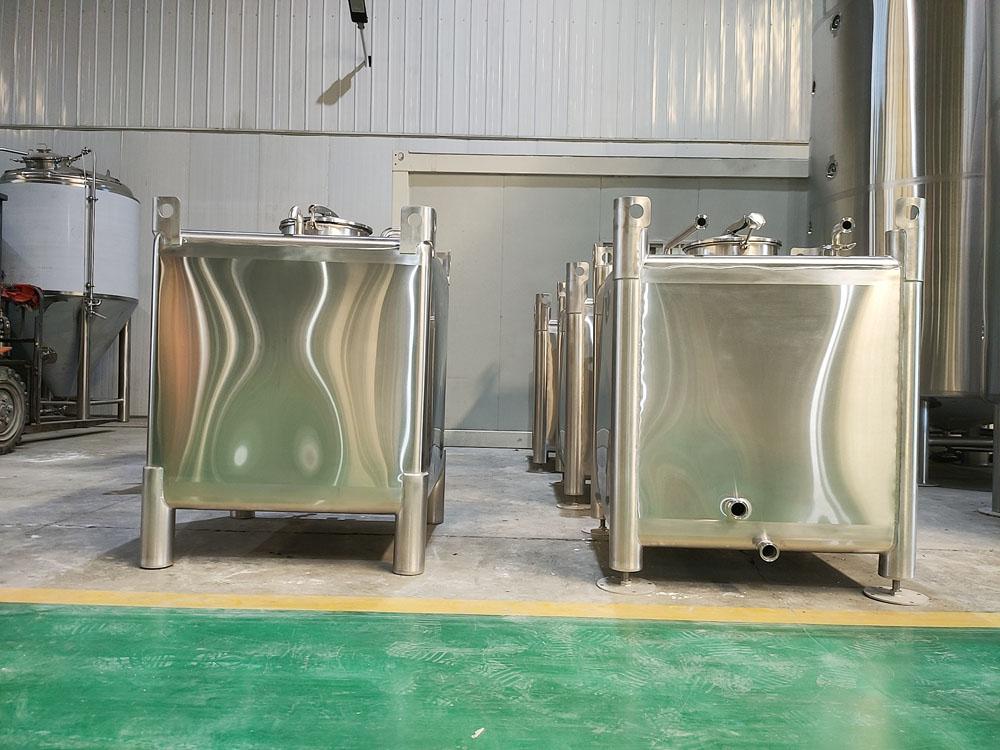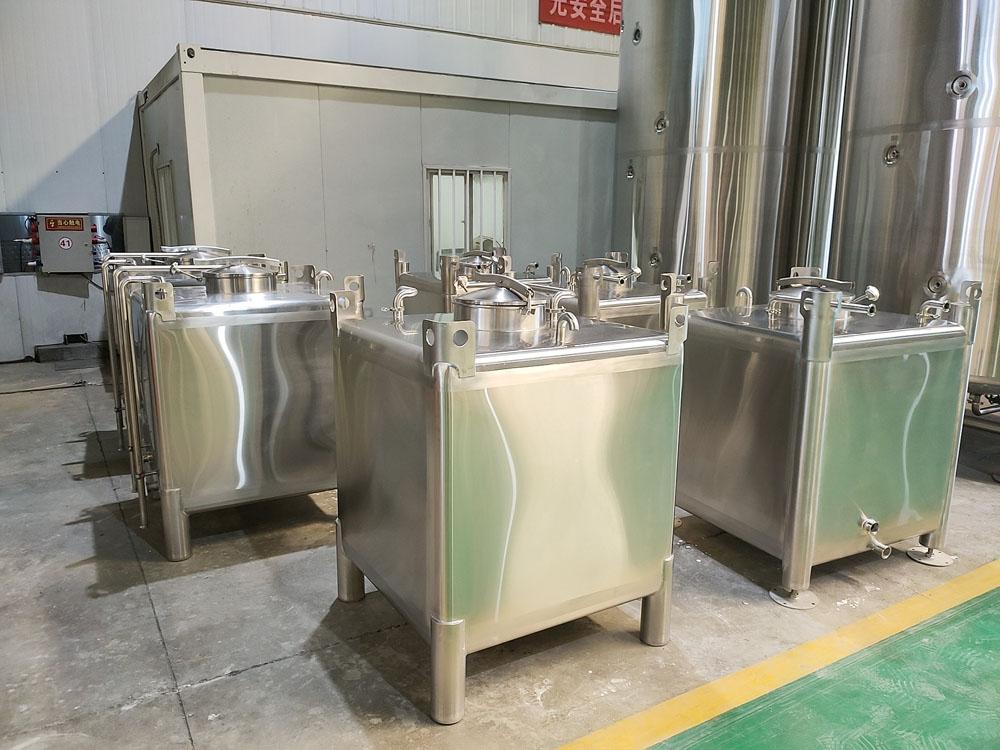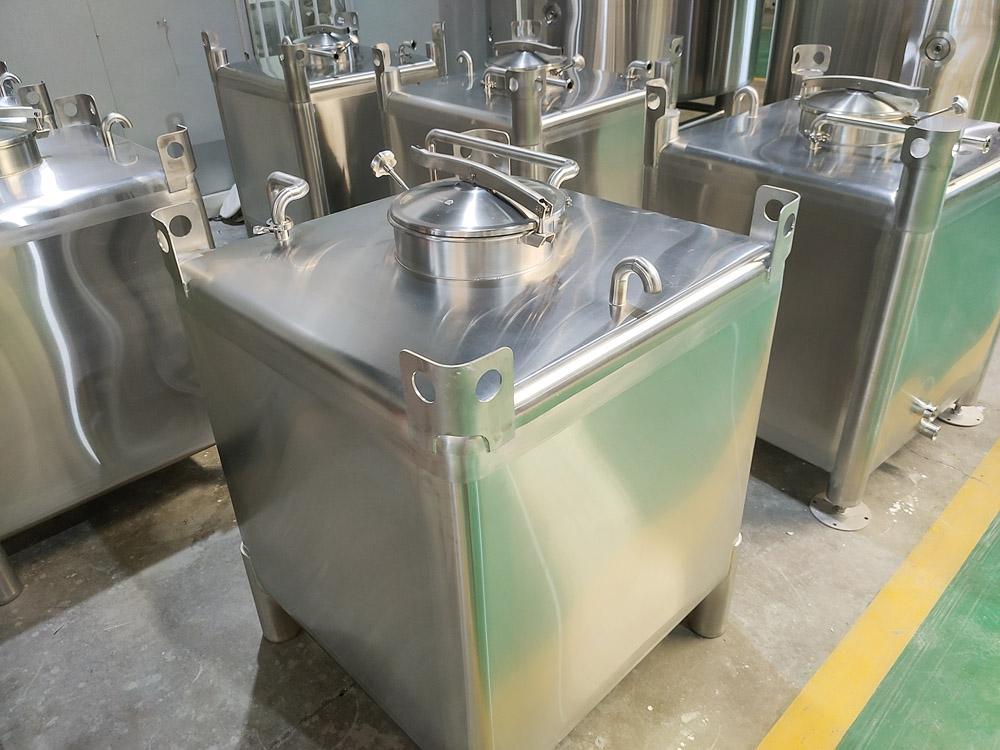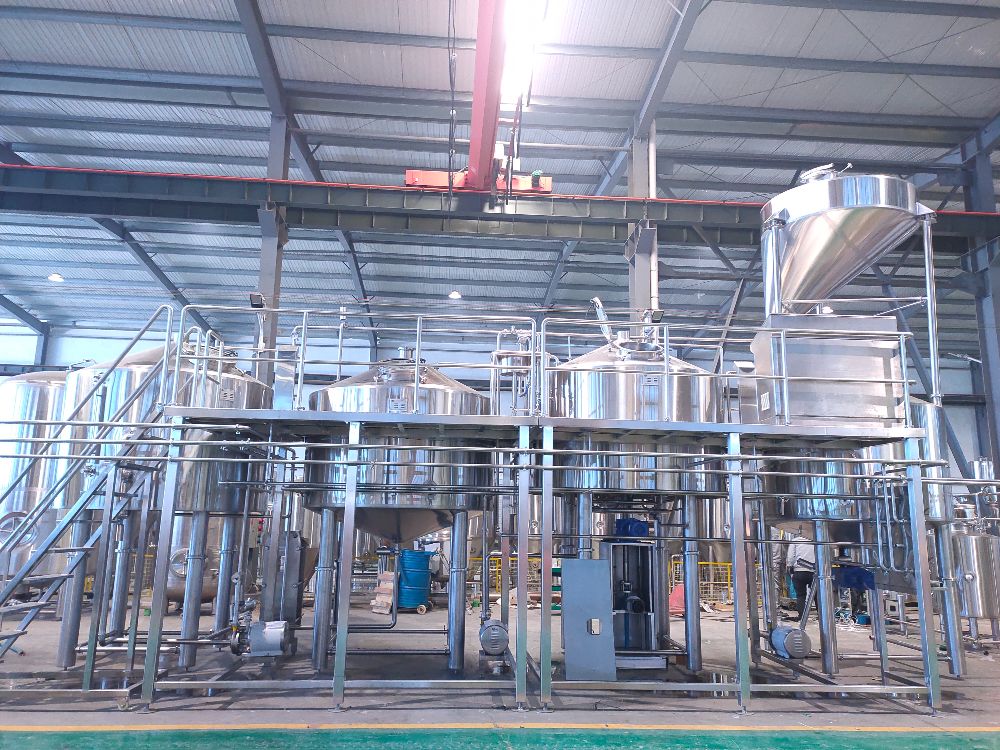Spirits storage tanks cubic shaped in distilleries
- Aug 16, 2024
- 135
- tiantai
When visiting distilleries, you should often see some cubic stainless steel tanks that are placed side by side or stacked. Usually, these cubic tanks are used to store spirits. Why are spirits storage tanks cubic shaped in distilleries? Do you have such question? Here, let us talk about it in details.

I: Why are spirits storage tanks cubic shaped in distilleries?
1. Space Efficiency
Maximizing Storage in Limited Space: The cubic design allows for better utilization of available space in a distillery. Unlike cylindrical tanks, cubic tanks can be placed side by side or stacked, minimizing gaps and allowing for more efficient storage, especially in tight spaces.
2. Capacity Optimization
Square Footprint: A cubic tank provides the maximum volume for a given floor area compared to a cylindrical tank. This is particularly beneficial in smaller distilleries or areas where space is at a premium.
3. Structural Simplicity
Easier to Manufacture and Handle: Cubic tanks may have simpler structural designs compared to spherical or cylindrical tanks, making them easier to manufacture and transport in certain situations. The flat surfaces of cubic tanks can make placement and securing easier as well.
4. Stackability
Efficient Use of Vertical Space: Cubic tanks can often be stacked more easily than cylindrical tanks, allowing distilleries to make better use of vertical space in their storage facilities.
5. Cost Efficiency
Manufacturing Costs: The production of cubic tanks can sometimes be more cost-effective, especially for smaller units. The design allows for the use of standardized components, which can reduce fabrication and installation costs.
6. Temperature Control
Uniform Temperature Distribution: In some cases, cubic tanks may offer better or more uniform temperature control for spirits storage. The straight walls of cubic tanks allow for more even insulation or cooling jackets, which helps in maintaining consistent temperature conditions for the stored spirits.

II: How should spirits storage tank be designed?
♦ Tank Capacity: Working Volume (+15% Headspace minimum)
♦ Tank Shell: SUS304 full welded; TH=1.5-2mm
♦ 100% TIG welding with pure argon gas shield
♦ Interior Finish: Sanitary 2B finish, Pickled and Passivated
♦ Exterior Finish: Oil brushed finish
♦ Interior full polished to 0.2~0.4 μm without dead corner
♦ Tank Working Pressure: atmospheric pressure
♦ Sanitary Top mounted manhole with door
♦ Top mounted double clamp 360° rotary CIP spraying ball and port
♦ With recirculation port on top via a TC fitting
♦ Sanitary level tube and valves
♦ Discharge arm with butterfly valve, Removable and easy to clean
♦ 4pcs completely SUS304 legs with braces
♦ 4 sets heavy duty foot pad
♦ Complete valves, fittings and all parts, Tri clamp/DIN Union available

III: How to decide size of spirits storage tank in distillery?
Deciding the size of a spirits storage tank in a distillery involves evaluating several key factors. These include production capacity, storage needs, available space, and future growth plans etc.
1. Production Capacity
Annual/Batch Production: Determine your distillery's annual or batch production volumes. If you’re producing 10,000 liters of spirits annually, your storage needs will depend on how much you store per batch and how long it stays in the tank.
Storage Time: The duration spirits need to be stored (whether for aging, post-distillation holding, or pre-bottling) affects the tank size. Longer aging or holding times will require larger or additional tanks.
2. Batch Size
Batch Storage Requirements: Your tank size should be able to accommodate the largest batch you expect to produce at one time. For example, if each batch yields 1,000 liters of spirits, your storage tank should have a minimum capacity of 1,000 liters.
Multiple Batches: If you plan to store multiple batches simultaneously, account for this in your tank sizing. Having separate tanks for different batches allows flexibility for blending or product differentiation.
3. Available Space
Floor Space: Assess the available floor space in your distillery for storage tanks. Cubic tanks are often preferred when maximizing space because they can be stacked or arranged more efficiently than cylindrical tanks.
Vertical Space: Consider ceiling height, as stacking tanks vertically can help maximize storage in smaller floor spaces. Ensure that tanks can be safely stacked and accessed for maintenance and filling.
4. Production Flow
Production Cycle: Look at how tanks fit into your production flow. If spirits move quickly from distillation to bottling, you may need smaller tanks with quicker turnover. However, for long-term aging or storage, larger tanks may be more efficient.
Tank Flexibility: Consider using multiple tanks for flexibility. Smaller tanks may allow you to store different spirits or batches separately, while larger tanks are useful for bulk storage or aging.
5. Future Growth Plans
Scalability: If you anticipate growing production in the future, consider installing tanks that allow for expansion. Investing in slightly larger tanks or leaving room to add more tanks later can help accommodate increased production.
Tank Addition: Plan for modularity—start with smaller tanks and add more as production increases, or choose tanks that can be upgraded or expanded.
6. Storage Conditions
Aging or Non-Aging: If the spirits require long-term aging (e.g., whiskey), larger tanks might be beneficial. For short-term storage (e.g., vodka or gin before bottling), smaller tanks might suffice.
Temperature Control: Tanks with temperature control features, such as insulation or cooling jackets, may require different sizes based on how much temperature-sensitive product needs to be stored.
7. Regulatory Requirements
Compliance: Check any legal or regulatory requirements that might dictate maximum or minimum storage capacities, particularly for hazardous materials like high-proof alcohol. Regulations may affect tank placement, size, and construction.
8. Budget Considerations
Cost: Larger tanks may offer economies of scale in terms of storage, but they also require higher initial investments. Balance the cost of larger tanks with the operational savings they might offer over time, considering how often they will be filled and utilized.
Efficiency vs. Cost: Larger tanks may reduce labor costs by minimizing the number of transfers and handling but can be more expensive to install, maintain, and clean.
Common Tank Sizes in Distilleries:
Small Distilleries: Tanks between 500L to 2,000L are typical for small-scale operations.
Medium Distilleries: 2,000L to 5,000L tanks are common, offering enough capacity for batch production while allowing flexibility for different products.
Large Distilleries: Tanks larger than 5,000L or even up to 10,000L or more are used for high-volume production or long-term aging of spirits like whiskey or rum.
Friends, our company manufactures 100L-10000L Spirits Storage tank. We have 2300+ global users in 86 countries. Any interests, feel free to contact us to get FREE quotation, drawing, layout and P&ID etc. Look forward to your inquiry.
Vicky
Sales director in Tiantai Beer Equipment Co
Email: [email protected]

I: Why are spirits storage tanks cubic shaped in distilleries?
1. Space Efficiency
Maximizing Storage in Limited Space: The cubic design allows for better utilization of available space in a distillery. Unlike cylindrical tanks, cubic tanks can be placed side by side or stacked, minimizing gaps and allowing for more efficient storage, especially in tight spaces.
2. Capacity Optimization
Square Footprint: A cubic tank provides the maximum volume for a given floor area compared to a cylindrical tank. This is particularly beneficial in smaller distilleries or areas where space is at a premium.
3. Structural Simplicity
Easier to Manufacture and Handle: Cubic tanks may have simpler structural designs compared to spherical or cylindrical tanks, making them easier to manufacture and transport in certain situations. The flat surfaces of cubic tanks can make placement and securing easier as well.
4. Stackability
Efficient Use of Vertical Space: Cubic tanks can often be stacked more easily than cylindrical tanks, allowing distilleries to make better use of vertical space in their storage facilities.
5. Cost Efficiency
Manufacturing Costs: The production of cubic tanks can sometimes be more cost-effective, especially for smaller units. The design allows for the use of standardized components, which can reduce fabrication and installation costs.
6. Temperature Control
Uniform Temperature Distribution: In some cases, cubic tanks may offer better or more uniform temperature control for spirits storage. The straight walls of cubic tanks allow for more even insulation or cooling jackets, which helps in maintaining consistent temperature conditions for the stored spirits.

II: How should spirits storage tank be designed?
♦ Tank Capacity: Working Volume (+15% Headspace minimum)
♦ Tank Shell: SUS304 full welded; TH=1.5-2mm
♦ 100% TIG welding with pure argon gas shield
♦ Interior Finish: Sanitary 2B finish, Pickled and Passivated
♦ Exterior Finish: Oil brushed finish
♦ Interior full polished to 0.2~0.4 μm without dead corner
♦ Tank Working Pressure: atmospheric pressure
♦ Sanitary Top mounted manhole with door
♦ Top mounted double clamp 360° rotary CIP spraying ball and port
♦ With recirculation port on top via a TC fitting
♦ Sanitary level tube and valves
♦ Discharge arm with butterfly valve, Removable and easy to clean
♦ 4pcs completely SUS304 legs with braces
♦ 4 sets heavy duty foot pad
♦ Complete valves, fittings and all parts, Tri clamp/DIN Union available

III: How to decide size of spirits storage tank in distillery?
Deciding the size of a spirits storage tank in a distillery involves evaluating several key factors. These include production capacity, storage needs, available space, and future growth plans etc.
1. Production Capacity
Annual/Batch Production: Determine your distillery's annual or batch production volumes. If you’re producing 10,000 liters of spirits annually, your storage needs will depend on how much you store per batch and how long it stays in the tank.
Storage Time: The duration spirits need to be stored (whether for aging, post-distillation holding, or pre-bottling) affects the tank size. Longer aging or holding times will require larger or additional tanks.
2. Batch Size
Batch Storage Requirements: Your tank size should be able to accommodate the largest batch you expect to produce at one time. For example, if each batch yields 1,000 liters of spirits, your storage tank should have a minimum capacity of 1,000 liters.
Multiple Batches: If you plan to store multiple batches simultaneously, account for this in your tank sizing. Having separate tanks for different batches allows flexibility for blending or product differentiation.
3. Available Space
Floor Space: Assess the available floor space in your distillery for storage tanks. Cubic tanks are often preferred when maximizing space because they can be stacked or arranged more efficiently than cylindrical tanks.
Vertical Space: Consider ceiling height, as stacking tanks vertically can help maximize storage in smaller floor spaces. Ensure that tanks can be safely stacked and accessed for maintenance and filling.
4. Production Flow
Production Cycle: Look at how tanks fit into your production flow. If spirits move quickly from distillation to bottling, you may need smaller tanks with quicker turnover. However, for long-term aging or storage, larger tanks may be more efficient.
Tank Flexibility: Consider using multiple tanks for flexibility. Smaller tanks may allow you to store different spirits or batches separately, while larger tanks are useful for bulk storage or aging.
5. Future Growth Plans
Scalability: If you anticipate growing production in the future, consider installing tanks that allow for expansion. Investing in slightly larger tanks or leaving room to add more tanks later can help accommodate increased production.
Tank Addition: Plan for modularity—start with smaller tanks and add more as production increases, or choose tanks that can be upgraded or expanded.
6. Storage Conditions
Aging or Non-Aging: If the spirits require long-term aging (e.g., whiskey), larger tanks might be beneficial. For short-term storage (e.g., vodka or gin before bottling), smaller tanks might suffice.
Temperature Control: Tanks with temperature control features, such as insulation or cooling jackets, may require different sizes based on how much temperature-sensitive product needs to be stored.
7. Regulatory Requirements
Compliance: Check any legal or regulatory requirements that might dictate maximum or minimum storage capacities, particularly for hazardous materials like high-proof alcohol. Regulations may affect tank placement, size, and construction.
8. Budget Considerations
Cost: Larger tanks may offer economies of scale in terms of storage, but they also require higher initial investments. Balance the cost of larger tanks with the operational savings they might offer over time, considering how often they will be filled and utilized.
Efficiency vs. Cost: Larger tanks may reduce labor costs by minimizing the number of transfers and handling but can be more expensive to install, maintain, and clean.
Common Tank Sizes in Distilleries:
Small Distilleries: Tanks between 500L to 2,000L are typical for small-scale operations.
Medium Distilleries: 2,000L to 5,000L tanks are common, offering enough capacity for batch production while allowing flexibility for different products.
Large Distilleries: Tanks larger than 5,000L or even up to 10,000L or more are used for high-volume production or long-term aging of spirits like whiskey or rum.
Friends, our company manufactures 100L-10000L Spirits Storage tank. We have 2300+ global users in 86 countries. Any interests, feel free to contact us to get FREE quotation, drawing, layout and P&ID etc. Look forward to your inquiry.
Vicky
Sales director in Tiantai Beer Equipment Co
Email: [email protected]




.jpg)